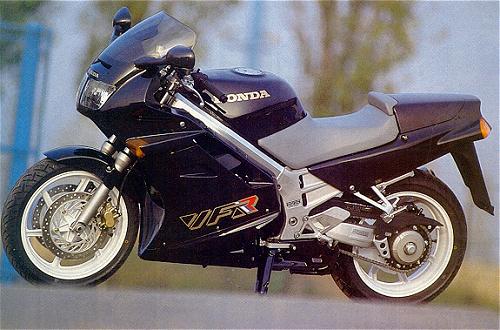Honda VFR750FL RC36 (1990)

"Honda's choice of a racetrack launch was a bit worrying. I kept my fingers crossed and hoped Honda hadn't race replicarised the VFR. They hadn't. But they've been fiddling with virtually every component in a bid to gnaw back the ZXR750's market lead.The wheelbase was shortened by 10mm, and the riding position was changed (Honda gave millimetre measurements, demonstrating their attention to detail). The pillion pegs were moved forward and lowered. The only criticisms from owners centre around the increased weight and smaller fuel tank. In all other respects most agreed "the best had just got better". The wheels were wide enough to accept the better radial tyres being introduced by manufacturers. It still occupied a niche of its own. While the Kawasaki ZXR and Suzuki GSX-R were outright 'head down, arse-up' race replicas, the VFR continued to tread a useful middle path. A track test alongside the two sports bikes showed that, while it couldn't lap quite as quickly, the VFR gave a good account of itself. The 1989 FK model retailed at £4749, while 12 months later the FL was £5799, but the price increase wasn't enough to dent sales, and it was still top of the sales charts.
Thankfully, Honda haven't trodden the well-worn path of tuning the VFR for more top end power to match its sportier clothing. Instead, it's the heads that have warranted the most work. The valve angles have been steepened, and the more compact heads allow the motor to be situated ever-so slightly further forwards and lower down. But it's the difference that the engine mods make to the midrange torque and flexibility that establish the new VFR as king of the roadbike market."
The 1990 Honda Press Pack, provided at the NEC show in November 1989, includes details of the changes made to the VFR:
- Valve operation changed from rocker arm to direct-push cam-on-valve-bucket type
- Valve angle changed from 19 to 16 degrees
- Cylinder head width reduced by 40mm
- Valve maintenance intervals tripled to 36,000kms
- Lighter cam gear-drive ratio changed from 2 to 1.75 for quieter running
- Carburettor angle increased from 40 to 52 degrees
- Larger air cleaner
- Heavier crankshaft to increase mid-range torque
- Engine moved forward by 34mm and lowered by 5.5mm
- Steering head angle changed from 27.5 to 26 degrees
- Wheelbase reduced by 10mm to 1470mm to promote 'quicker' steering
- Main frame section increased from 60mm x 28mm to 80mm x 30mm
- Handlebar position moved forward 33mm and lowered by 40mm
- Footrests lowered by 26mm and moved forward by 46mm
- Riding position (at riders hip) lowered by 12mm and moved forward by 68mm
- Passenger footrests relocated 56mm forward and lowered by 23mm
- Pillion hand grips provided on both sides of the bike
- New ram air screen, first uder on 1989 CBR1000F
- High penetration twin-bulb 60/55w headlamp
- Low profile radial tyres (Bridgestone or Michelin)
- Integrated front and rear indicators
- Extended under-cowling and faired side-stand improve aerodynamics
| VFR750FL | |
| Front tyre Rear tyre Wheelbase Dry weight Power Torque |
120/70 170/60 1470mm 216kg (476lb) 98.5bhp @ 9,700rpm 53.9 lb-ft @ 9,000rpm |
Related links